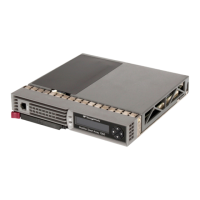12 Overview and setup
CLI commands in redundant configurations
When an MSA has two controllers, the same firmware image is run on both controllers. The two controllers
communicate with each other through a PCI bus called the inter-controller link (ICL). Each controller has a
serial port and has a CLI available to the users who connect the serial port to a serial terminal.
Some CLI commands are entered from one controller’s CLI prompt but are executed from the other
controller. Command syntax instructs the controller to accept user input, pass the command to the other
controller, and then display the result.
The following keywords are used in the CLI to indicate a specific controller:
• this_controller—is included in command syntax to refer to the controller that the CLI is connected
to.
• other_controller—is included in command syntax to refer to the other controller in the MSA.
CLI command syntax
As previously mentioned, commands are entered at the CLI prompt. Commands are not case sensitive and
must be typed out in full.
CLI command strings include the basic command plus specific command options, some of which are
mandatory and some of which are optional.
The CLI does not support line-continuation characters. If all characters of a command do not fit on one line
of the CLI, let them wrap around to the next line on the screen. The maximum command length is 255
characters.
Example command
add unit 0 data=”disk101-disk103” raid_level=0
This example command has three portions—the basic command, plus two required command options.
Basic command
add unit <#> data=”diskrange” raid_level=r
The basic command includes a word or phrase used to instruct the controller. Commands usually contain a
verb with a noun. Every CLI command must begin with a basic command.
Command options
#—the number to assign to the LUN.
data=”diskrange”—the number of an individual drive or range of drives to incorporate into the
LUN. Disks are identified by box number and bay number. For example, disk101 through disk103
identifies disks 1 through 3 in box number 1.
raid_level=r—the RAID fault-tolerance level to use, where r represents:
0 = RAID 0 (no fault tolerance)
1 = RAID 1 (mirroring)
5 = RAID 5 (distributed parity)
6 = RAID 6 (advanced data guarding (ADG))
An option is defined as words or phrases listed after the basic command that supply necessary information
to support the command. If an option is required but not entered, the CLI command string is considered
invalid. If an option is available but not required, a default value is used.

